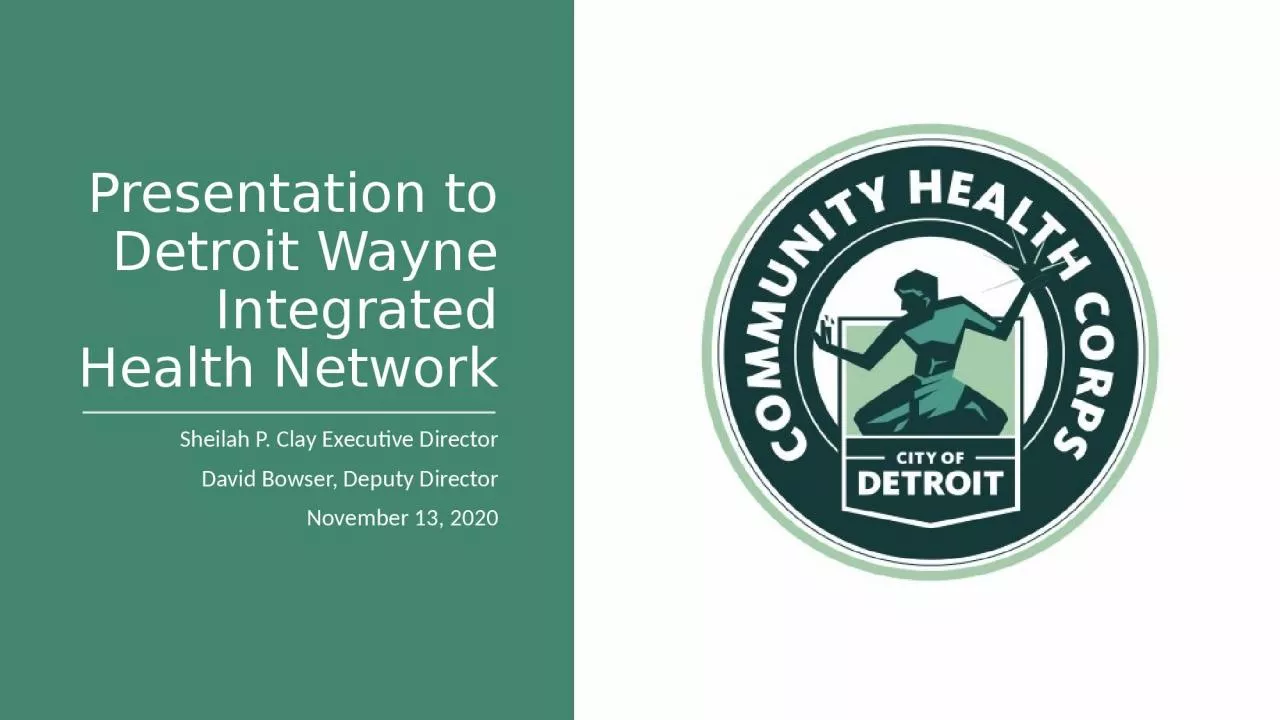

Sheilah P Clay Executive Director David Bowser Deputy Director November 13 2020 Health is Personal The Community Health Corps takes an individualcentered total care approach to overcome poverty and provide connection to available resources ID: 1044140
Download Presentation The PPT/PDF document "Presentation to Detroit Wayne Integrated..." is the property of its rightful owner. Permission is granted to download and print the materials on this web site for personal, non-commercial use only, and to display it on your personal computer provided you do not modify the materials and that you retain all copyright notices contained in the materials. By downloading content from our website, you accept the terms of this agreement.
1. Presentation to Detroit Wayne Integrated Health NetworkSheilah P. Clay Executive DirectorDavid Bowser, Deputy DirectorNovember 13, 2020
2.
3. Health is Personal.The Community Health Corps takes an individual-centered total care approach to overcome poverty and provide connection to available resources.
4. 4That was prior to COVID-19.Detroit residents who were isolated and in crisis before still need support.Detroit residents who were on the edge of isolation or crisis have likely tipped over that edge, making the need for the Community Health Corps even more acute.The next three years are critical to Detroit’s recovery. The Community Health Corps connects residents to supports and services, and confronts this challenge by investing in people.
5.
6. Door-to-Door CHC Material6
7.
8. CHC Emergency Housing & Disaster Relief Branch (ESG/CDBG)Precariously Housed OutreachDoor-to-door outreach to Detroit Land Bank Authority (DLBA) or land developer-owned, occupied propertiesMany homes are in a state of uninhabitable disrepair with no utilitiesRestorative, wraparound case management to transform occupants into homeowners and renters CODE BLUEMulti-organizational, emergency response to mass housing displacement events (5+ units): Fires, condemned residential buildings and other emergencies escalated by the media and the City of Detroit Mayor’s OfficeParticipants: CHC, Mayor’s Office, Law, DPD, DFD, BSEED, HRD, Homeland Security, Parks and Recreation, American Red Cross, UCHCEmergency case management to connect displaced individuals to permanent housing, and to replace items that were lost in the disaster
9. The CHC does not act alone.Overcoming poverty is a big goal.Unemployment rates have increased, and food, utility and housing insecurity directly tied to the lack of income magnify the risks of physical and behavioral health challenges. Black and Brown workers have been more likely to lose their jobs or to work in industries with increased COVID-19 risk. The entry-level jobs held by many Detroiters and people of color are most at risk of automation. CODEBLUE
10. Comprehensive assessment by CHC Lead CSM that includes behavioral health questions.Client includes and agrees to behavioral health services in Passport (service plan).Contact DWIHN Access Center to refer client and/or check for current or past service status.Assist client in connecting with DWIHN service provider. This includes providing transportation, if needed. If approved by client and ROIs signed, serve on wrap-around team and follow-up with provider on minimum monthly basis for client status and progress.CHC will have direct partnership relationship with MRS, CAM, and the Detroit Health Department.10
11. Phase 1Phase 2Phase 3October 1, 2020 – March 31, 2021Hire 1 pod, and 4 additional case managers dedicated to Code Blue and housing supportIntegrate CHC case management and referral support for 60 existing clients, and on-ramp support for at least 100 additional clients. Track the number of clients who transition to lighter touch support to better understand 1 pod average-caseload capacity. As additional funding is secured, expand to 3 pods, each with the capacity to serve at least 160 clients, for a total program caseload of at least 480 Detroit residentsApril 1, 2021 – December 31, 2021As additional funding is secured, ramp to full scale of pilot: 3 podsInitial evaluation of program impact will emerge – assess progress from the client’s perspective in addition to evaluating outcomes reported by the referral partnersValidate caseload capacity and scale-ability of modelJanuary 1, 2022 – December 31, 2022Maintain active caseload for 5 podsContinue evaluation of program impact, and validation of scale-abilityIf CHC pilot shows significant multiplier effect over traditional referrals, develop program design and sustainability model to continue scalingIf CHC pilot does not show improved impact over traditional referrals, begin wind down of program and transition of remaining clients
12. Q & AContact Info:Sheilah P. Clayclays@detroitmi.govDavid Bowserbowserd@detroitmi.gov